NHS: Inter-Professional Approaches to Service Delivery Report
VerifiedAdded on 2023/01/05
|11
|3742
|79
Report
AI Summary
This report delves into inter-professional approaches to service delivery within the healthcare sector, emphasizing the significance of collaborative working, particularly within the NHS. It highlights the importance of local collaboration in improving patient outcomes and explores various professional approaches employed in health and social care. The study examines how collaborative efforts among healthcare professionals, including multidisciplinary teams, nurses, and doctors, lead to enhanced patient care and more efficient service delivery. The report underscores the role of effective communication, shared knowledge, and positive relationships in fostering a patient-centered approach. It also discusses the impact of boundary spanning on promoting effective practices and reducing healthcare costs. Furthermore, it touches upon the different types of health and social care services, such as primary, secondary, tertiary, and palliative care, provided by the NHS to cater to diverse patient needs. The report concludes by emphasizing the benefits of inter-professional collaboration in enhancing healthcare quality, patient satisfaction, and overall operational efficiency within healthcare settings.

Inter - Professional
Approaches to Service
Delivery
Approaches to Service
Delivery
Paraphrase This Document
Need a fresh take? Get an instant paraphrase of this document with our AI Paraphraser
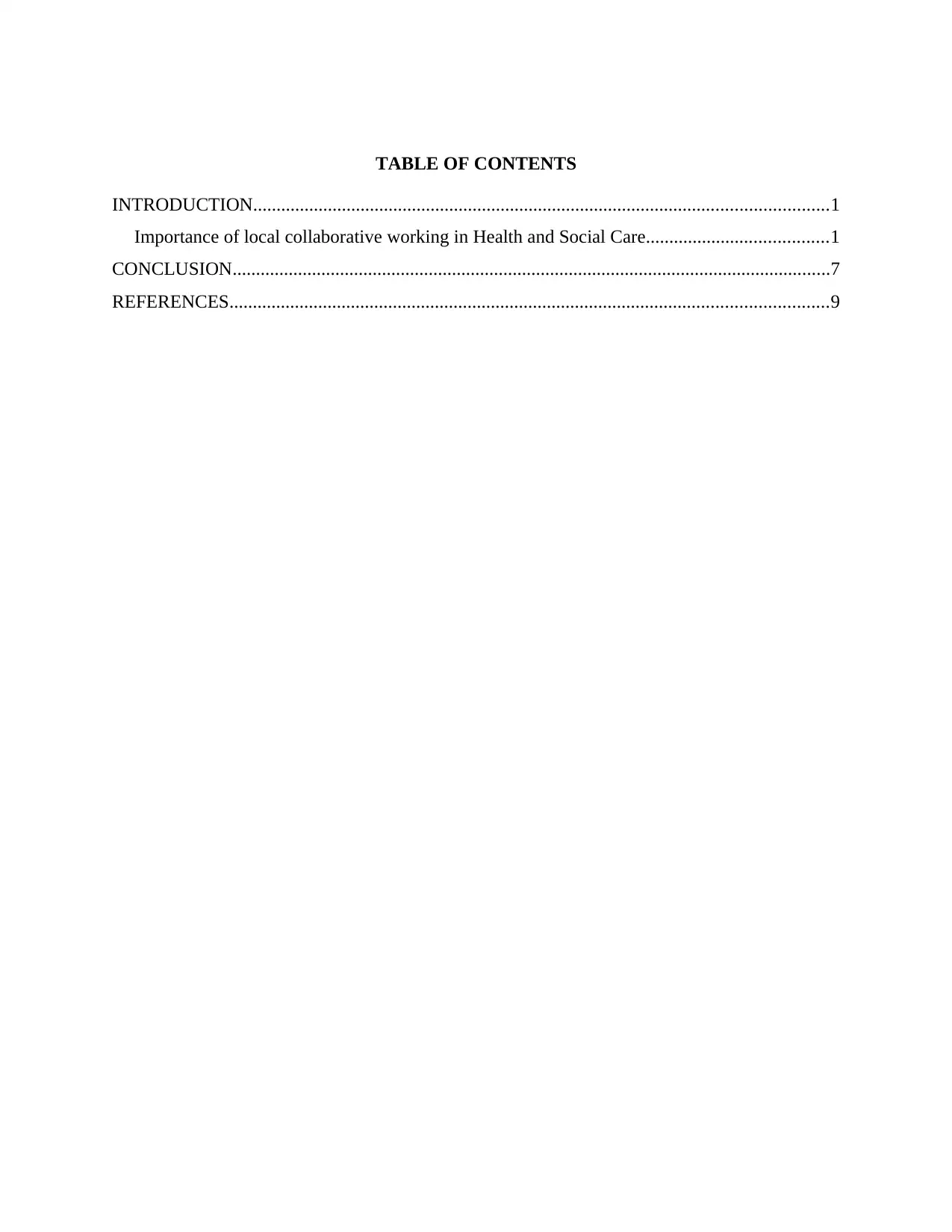
TABLE OF CONTENTS
INTRODUCTION...........................................................................................................................1
Importance of local collaborative working in Health and Social Care.......................................1
CONCLUSION................................................................................................................................7
REFERENCES................................................................................................................................9
INTRODUCTION...........................................................................................................................1
Importance of local collaborative working in Health and Social Care.......................................1
CONCLUSION................................................................................................................................7
REFERENCES................................................................................................................................9
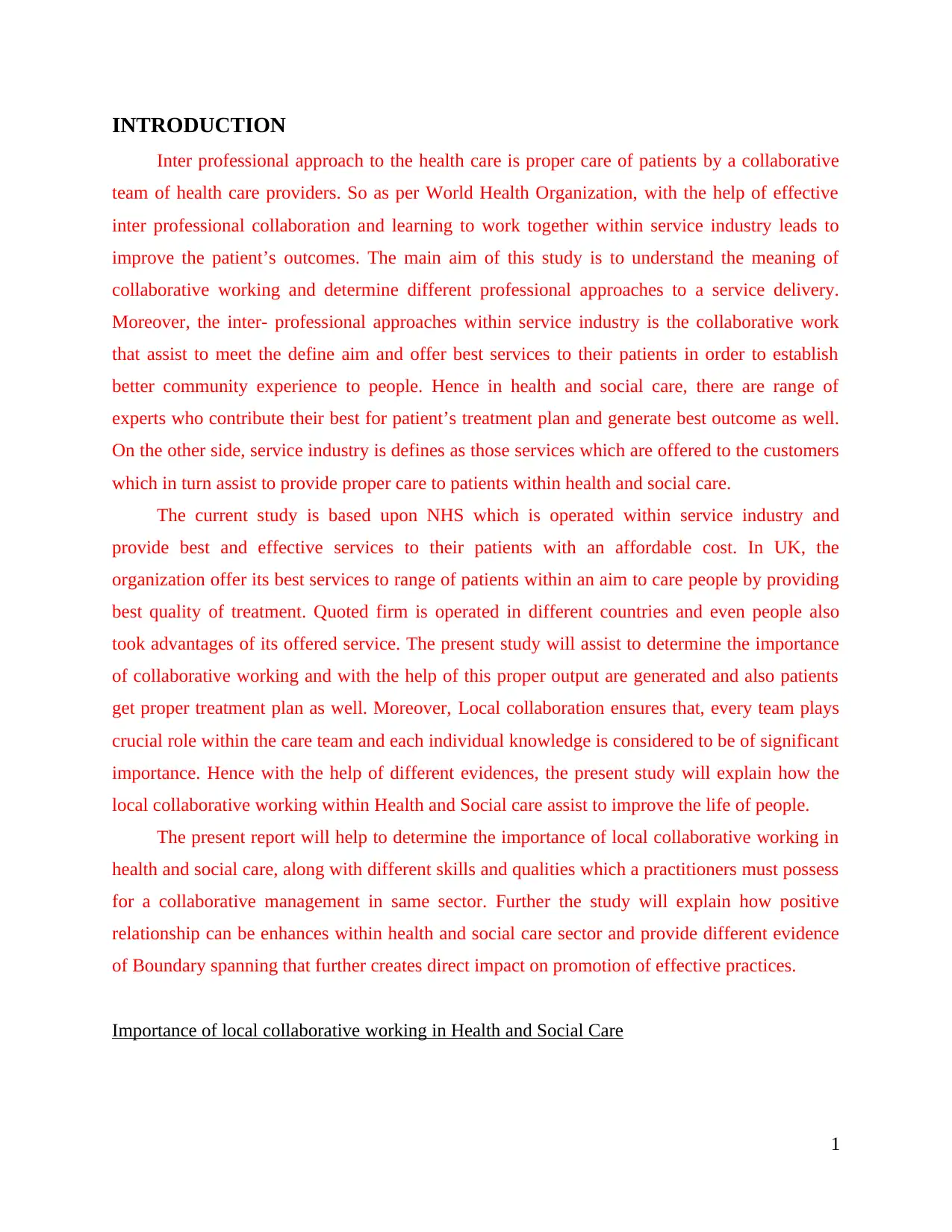
INTRODUCTION
Inter professional approach to the health care is proper care of patients by a collaborative
team of health care providers. So as per World Health Organization, with the help of effective
inter professional collaboration and learning to work together within service industry leads to
improve the patient’s outcomes. The main aim of this study is to understand the meaning of
collaborative working and determine different professional approaches to a service delivery.
Moreover, the inter- professional approaches within service industry is the collaborative work
that assist to meet the define aim and offer best services to their patients in order to establish
better community experience to people. Hence in health and social care, there are range of
experts who contribute their best for patient’s treatment plan and generate best outcome as well.
On the other side, service industry is defines as those services which are offered to the customers
which in turn assist to provide proper care to patients within health and social care.
The current study is based upon NHS which is operated within service industry and
provide best and effective services to their patients with an affordable cost. In UK, the
organization offer its best services to range of patients within an aim to care people by providing
best quality of treatment. Quoted firm is operated in different countries and even people also
took advantages of its offered service. The present study will assist to determine the importance
of collaborative working and with the help of this proper output are generated and also patients
get proper treatment plan as well. Moreover, Local collaboration ensures that, every team plays
crucial role within the care team and each individual knowledge is considered to be of significant
importance. Hence with the help of different evidences, the present study will explain how the
local collaborative working within Health and Social care assist to improve the life of people.
The present report will help to determine the importance of local collaborative working in
health and social care, along with different skills and qualities which a practitioners must possess
for a collaborative management in same sector. Further the study will explain how positive
relationship can be enhances within health and social care sector and provide different evidence
of Boundary spanning that further creates direct impact on promotion of effective practices.
Importance of local collaborative working in Health and Social Care
1
Inter professional approach to the health care is proper care of patients by a collaborative
team of health care providers. So as per World Health Organization, with the help of effective
inter professional collaboration and learning to work together within service industry leads to
improve the patient’s outcomes. The main aim of this study is to understand the meaning of
collaborative working and determine different professional approaches to a service delivery.
Moreover, the inter- professional approaches within service industry is the collaborative work
that assist to meet the define aim and offer best services to their patients in order to establish
better community experience to people. Hence in health and social care, there are range of
experts who contribute their best for patient’s treatment plan and generate best outcome as well.
On the other side, service industry is defines as those services which are offered to the customers
which in turn assist to provide proper care to patients within health and social care.
The current study is based upon NHS which is operated within service industry and
provide best and effective services to their patients with an affordable cost. In UK, the
organization offer its best services to range of patients within an aim to care people by providing
best quality of treatment. Quoted firm is operated in different countries and even people also
took advantages of its offered service. The present study will assist to determine the importance
of collaborative working and with the help of this proper output are generated and also patients
get proper treatment plan as well. Moreover, Local collaboration ensures that, every team plays
crucial role within the care team and each individual knowledge is considered to be of significant
importance. Hence with the help of different evidences, the present study will explain how the
local collaborative working within Health and Social care assist to improve the life of people.
The present report will help to determine the importance of local collaborative working in
health and social care, along with different skills and qualities which a practitioners must possess
for a collaborative management in same sector. Further the study will explain how positive
relationship can be enhances within health and social care sector and provide different evidence
of Boundary spanning that further creates direct impact on promotion of effective practices.
Importance of local collaborative working in Health and Social Care
1
⊘ This is a preview!⊘
Do you want full access?
Subscribe today to unlock all pages.

Trusted by 1+ million students worldwide
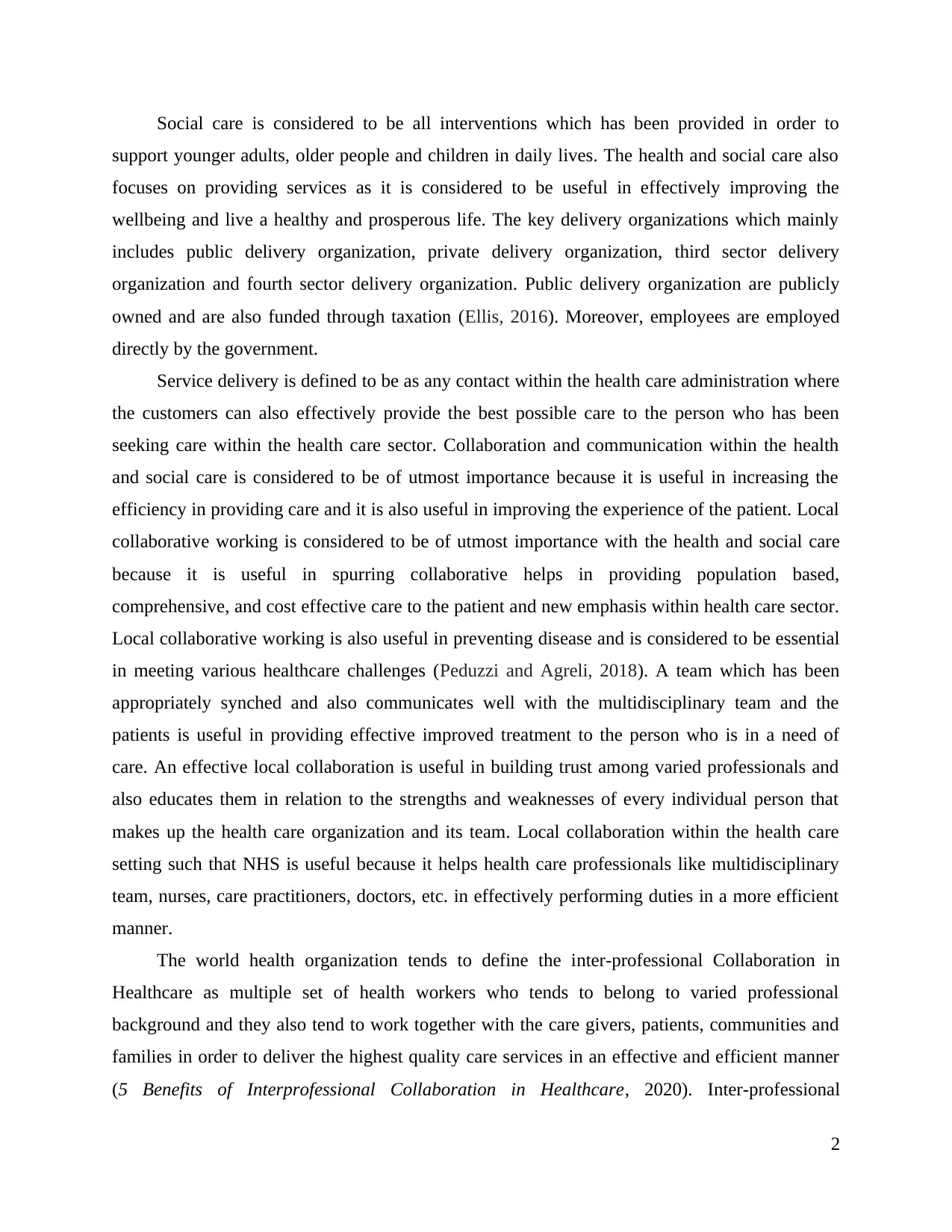
Social care is considered to be all interventions which has been provided in order to
support younger adults, older people and children in daily lives. The health and social care also
focuses on providing services as it is considered to be useful in effectively improving the
wellbeing and live a healthy and prosperous life. The key delivery organizations which mainly
includes public delivery organization, private delivery organization, third sector delivery
organization and fourth sector delivery organization. Public delivery organization are publicly
owned and are also funded through taxation (Ellis, 2016). Moreover, employees are employed
directly by the government.
Service delivery is defined to be as any contact within the health care administration where
the customers can also effectively provide the best possible care to the person who has been
seeking care within the health care sector. Collaboration and communication within the health
and social care is considered to be of utmost importance because it is useful in increasing the
efficiency in providing care and it is also useful in improving the experience of the patient. Local
collaborative working is considered to be of utmost importance with the health and social care
because it is useful in spurring collaborative helps in providing population based,
comprehensive, and cost effective care to the patient and new emphasis within health care sector.
Local collaborative working is also useful in preventing disease and is considered to be essential
in meeting various healthcare challenges (Peduzzi and Agreli, 2018). A team which has been
appropriately synched and also communicates well with the multidisciplinary team and the
patients is useful in providing effective improved treatment to the person who is in a need of
care. An effective local collaboration is useful in building trust among varied professionals and
also educates them in relation to the strengths and weaknesses of every individual person that
makes up the health care organization and its team. Local collaboration within the health care
setting such that NHS is useful because it helps health care professionals like multidisciplinary
team, nurses, care practitioners, doctors, etc. in effectively performing duties in a more efficient
manner.
The world health organization tends to define the inter-professional Collaboration in
Healthcare as multiple set of health workers who tends to belong to varied professional
background and they also tend to work together with the care givers, patients, communities and
families in order to deliver the highest quality care services in an effective and efficient manner
(5 Benefits of Interprofessional Collaboration in Healthcare, 2020). Inter-professional
2
support younger adults, older people and children in daily lives. The health and social care also
focuses on providing services as it is considered to be useful in effectively improving the
wellbeing and live a healthy and prosperous life. The key delivery organizations which mainly
includes public delivery organization, private delivery organization, third sector delivery
organization and fourth sector delivery organization. Public delivery organization are publicly
owned and are also funded through taxation (Ellis, 2016). Moreover, employees are employed
directly by the government.
Service delivery is defined to be as any contact within the health care administration where
the customers can also effectively provide the best possible care to the person who has been
seeking care within the health care sector. Collaboration and communication within the health
and social care is considered to be of utmost importance because it is useful in increasing the
efficiency in providing care and it is also useful in improving the experience of the patient. Local
collaborative working is considered to be of utmost importance with the health and social care
because it is useful in spurring collaborative helps in providing population based,
comprehensive, and cost effective care to the patient and new emphasis within health care sector.
Local collaborative working is also useful in preventing disease and is considered to be essential
in meeting various healthcare challenges (Peduzzi and Agreli, 2018). A team which has been
appropriately synched and also communicates well with the multidisciplinary team and the
patients is useful in providing effective improved treatment to the person who is in a need of
care. An effective local collaboration is useful in building trust among varied professionals and
also educates them in relation to the strengths and weaknesses of every individual person that
makes up the health care organization and its team. Local collaboration within the health care
setting such that NHS is useful because it helps health care professionals like multidisciplinary
team, nurses, care practitioners, doctors, etc. in effectively performing duties in a more efficient
manner.
The world health organization tends to define the inter-professional Collaboration in
Healthcare as multiple set of health workers who tends to belong to varied professional
background and they also tend to work together with the care givers, patients, communities and
families in order to deliver the highest quality care services in an effective and efficient manner
(5 Benefits of Interprofessional Collaboration in Healthcare, 2020). Inter-professional
2
Paraphrase This Document
Need a fresh take? Get an instant paraphrase of this document with our AI Paraphraser
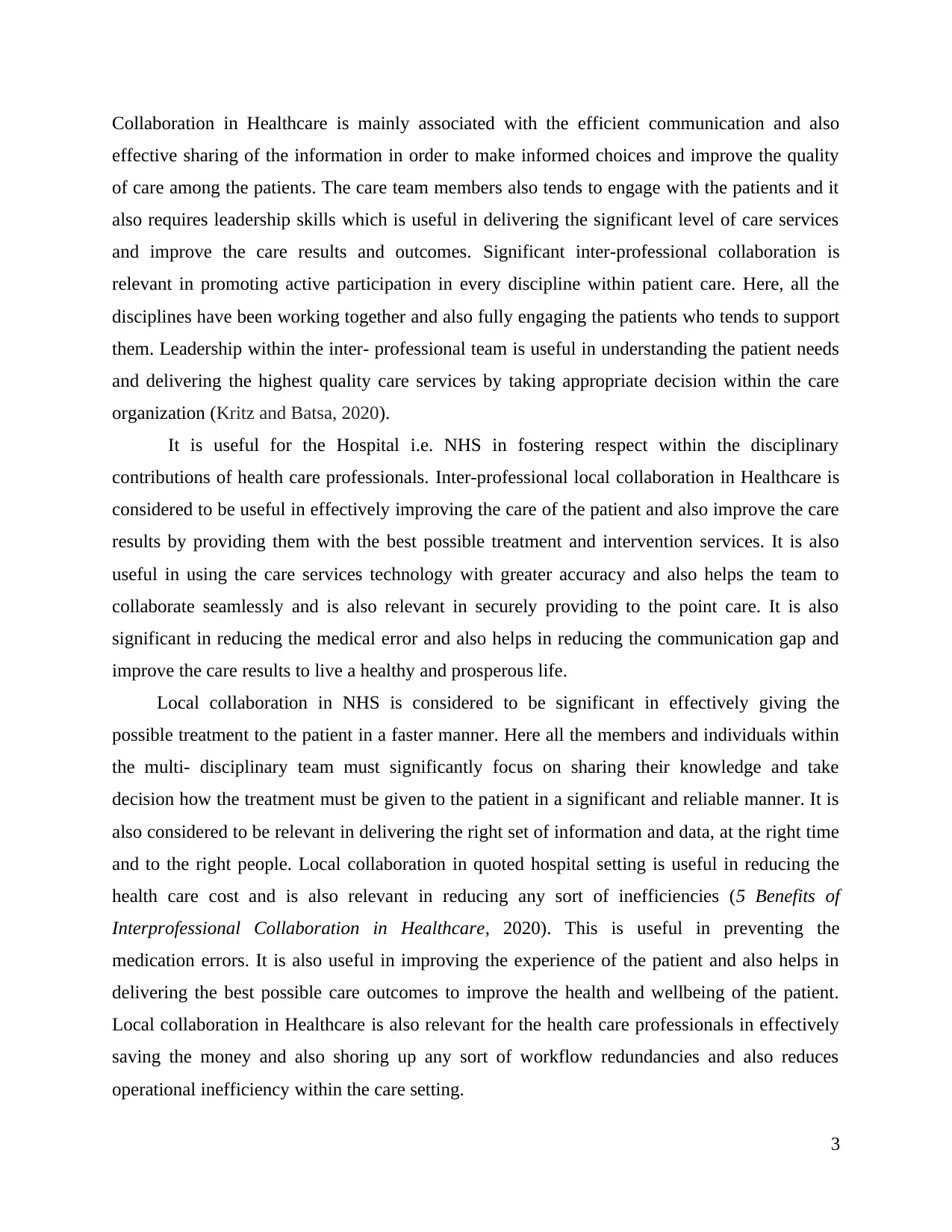
Collaboration in Healthcare is mainly associated with the efficient communication and also
effective sharing of the information in order to make informed choices and improve the quality
of care among the patients. The care team members also tends to engage with the patients and it
also requires leadership skills which is useful in delivering the significant level of care services
and improve the care results and outcomes. Significant inter-professional collaboration is
relevant in promoting active participation in every discipline within patient care. Here, all the
disciplines have been working together and also fully engaging the patients who tends to support
them. Leadership within the inter- professional team is useful in understanding the patient needs
and delivering the highest quality care services by taking appropriate decision within the care
organization (Kritz and Batsa, 2020).
It is useful for the Hospital i.e. NHS in fostering respect within the disciplinary
contributions of health care professionals. Inter-professional local collaboration in Healthcare is
considered to be useful in effectively improving the care of the patient and also improve the care
results by providing them with the best possible treatment and intervention services. It is also
useful in using the care services technology with greater accuracy and also helps the team to
collaborate seamlessly and is also relevant in securely providing to the point care. It is also
significant in reducing the medical error and also helps in reducing the communication gap and
improve the care results to live a healthy and prosperous life.
Local collaboration in NHS is considered to be significant in effectively giving the
possible treatment to the patient in a faster manner. Here all the members and individuals within
the multi- disciplinary team must significantly focus on sharing their knowledge and take
decision how the treatment must be given to the patient in a significant and reliable manner. It is
also considered to be relevant in delivering the right set of information and data, at the right time
and to the right people. Local collaboration in quoted hospital setting is useful in reducing the
health care cost and is also relevant in reducing any sort of inefficiencies (5 Benefits of
Interprofessional Collaboration in Healthcare, 2020). This is useful in preventing the
medication errors. It is also useful in improving the experience of the patient and also helps in
delivering the best possible care outcomes to improve the health and wellbeing of the patient.
Local collaboration in Healthcare is also relevant for the health care professionals in effectively
saving the money and also shoring up any sort of workflow redundancies and also reduces
operational inefficiency within the care setting.
3
effective sharing of the information in order to make informed choices and improve the quality
of care among the patients. The care team members also tends to engage with the patients and it
also requires leadership skills which is useful in delivering the significant level of care services
and improve the care results and outcomes. Significant inter-professional collaboration is
relevant in promoting active participation in every discipline within patient care. Here, all the
disciplines have been working together and also fully engaging the patients who tends to support
them. Leadership within the inter- professional team is useful in understanding the patient needs
and delivering the highest quality care services by taking appropriate decision within the care
organization (Kritz and Batsa, 2020).
It is useful for the Hospital i.e. NHS in fostering respect within the disciplinary
contributions of health care professionals. Inter-professional local collaboration in Healthcare is
considered to be useful in effectively improving the care of the patient and also improve the care
results by providing them with the best possible treatment and intervention services. It is also
useful in using the care services technology with greater accuracy and also helps the team to
collaborate seamlessly and is also relevant in securely providing to the point care. It is also
significant in reducing the medical error and also helps in reducing the communication gap and
improve the care results to live a healthy and prosperous life.
Local collaboration in NHS is considered to be significant in effectively giving the
possible treatment to the patient in a faster manner. Here all the members and individuals within
the multi- disciplinary team must significantly focus on sharing their knowledge and take
decision how the treatment must be given to the patient in a significant and reliable manner. It is
also considered to be relevant in delivering the right set of information and data, at the right time
and to the right people. Local collaboration in quoted hospital setting is useful in reducing the
health care cost and is also relevant in reducing any sort of inefficiencies (5 Benefits of
Interprofessional Collaboration in Healthcare, 2020). This is useful in preventing the
medication errors. It is also useful in improving the experience of the patient and also helps in
delivering the best possible care outcomes to improve the health and wellbeing of the patient.
Local collaboration in Healthcare is also relevant for the health care professionals in effectively
saving the money and also shoring up any sort of workflow redundancies and also reduces
operational inefficiency within the care setting.
3
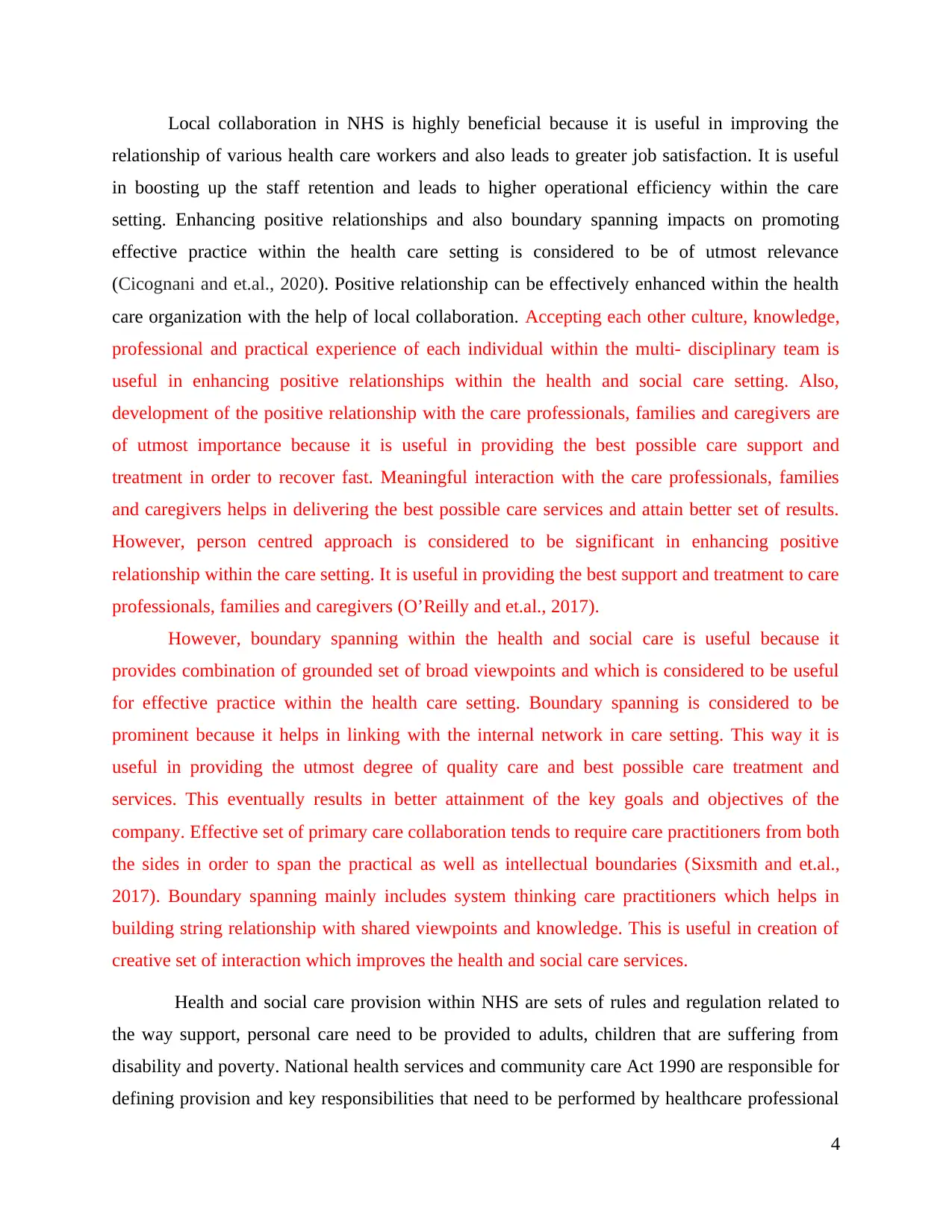
Local collaboration in NHS is highly beneficial because it is useful in improving the
relationship of various health care workers and also leads to greater job satisfaction. It is useful
in boosting up the staff retention and leads to higher operational efficiency within the care
setting. Enhancing positive relationships and also boundary spanning impacts on promoting
effective practice within the health care setting is considered to be of utmost relevance
(Cicognani and et.al., 2020). Positive relationship can be effectively enhanced within the health
care organization with the help of local collaboration. Accepting each other culture, knowledge,
professional and practical experience of each individual within the multi- disciplinary team is
useful in enhancing positive relationships within the health and social care setting. Also,
development of the positive relationship with the care professionals, families and caregivers are
of utmost importance because it is useful in providing the best possible care support and
treatment in order to recover fast. Meaningful interaction with the care professionals, families
and caregivers helps in delivering the best possible care services and attain better set of results.
However, person centred approach is considered to be significant in enhancing positive
relationship within the care setting. It is useful in providing the best support and treatment to care
professionals, families and caregivers (O’Reilly and et.al., 2017).
However, boundary spanning within the health and social care is useful because it
provides combination of grounded set of broad viewpoints and which is considered to be useful
for effective practice within the health care setting. Boundary spanning is considered to be
prominent because it helps in linking with the internal network in care setting. This way it is
useful in providing the utmost degree of quality care and best possible care treatment and
services. This eventually results in better attainment of the key goals and objectives of the
company. Effective set of primary care collaboration tends to require care practitioners from both
the sides in order to span the practical as well as intellectual boundaries (Sixsmith and et.al.,
2017). Boundary spanning mainly includes system thinking care practitioners which helps in
building string relationship with shared viewpoints and knowledge. This is useful in creation of
creative set of interaction which improves the health and social care services.
Health and social care provision within NHS are sets of rules and regulation related to
the way support, personal care need to be provided to adults, children that are suffering from
disability and poverty. National health services and community care Act 1990 are responsible for
defining provision and key responsibilities that need to be performed by healthcare professional
4
relationship of various health care workers and also leads to greater job satisfaction. It is useful
in boosting up the staff retention and leads to higher operational efficiency within the care
setting. Enhancing positive relationships and also boundary spanning impacts on promoting
effective practice within the health care setting is considered to be of utmost relevance
(Cicognani and et.al., 2020). Positive relationship can be effectively enhanced within the health
care organization with the help of local collaboration. Accepting each other culture, knowledge,
professional and practical experience of each individual within the multi- disciplinary team is
useful in enhancing positive relationships within the health and social care setting. Also,
development of the positive relationship with the care professionals, families and caregivers are
of utmost importance because it is useful in providing the best possible care support and
treatment in order to recover fast. Meaningful interaction with the care professionals, families
and caregivers helps in delivering the best possible care services and attain better set of results.
However, person centred approach is considered to be significant in enhancing positive
relationship within the care setting. It is useful in providing the best support and treatment to care
professionals, families and caregivers (O’Reilly and et.al., 2017).
However, boundary spanning within the health and social care is useful because it
provides combination of grounded set of broad viewpoints and which is considered to be useful
for effective practice within the health care setting. Boundary spanning is considered to be
prominent because it helps in linking with the internal network in care setting. This way it is
useful in providing the utmost degree of quality care and best possible care treatment and
services. This eventually results in better attainment of the key goals and objectives of the
company. Effective set of primary care collaboration tends to require care practitioners from both
the sides in order to span the practical as well as intellectual boundaries (Sixsmith and et.al.,
2017). Boundary spanning mainly includes system thinking care practitioners which helps in
building string relationship with shared viewpoints and knowledge. This is useful in creation of
creative set of interaction which improves the health and social care services.
Health and social care provision within NHS are sets of rules and regulation related to
the way support, personal care need to be provided to adults, children that are suffering from
disability and poverty. National health services and community care Act 1990 are responsible for
defining provision and key responsibilities that need to be performed by healthcare professional
4
⊘ This is a preview!⊘
Do you want full access?
Subscribe today to unlock all pages.

Trusted by 1+ million students worldwide
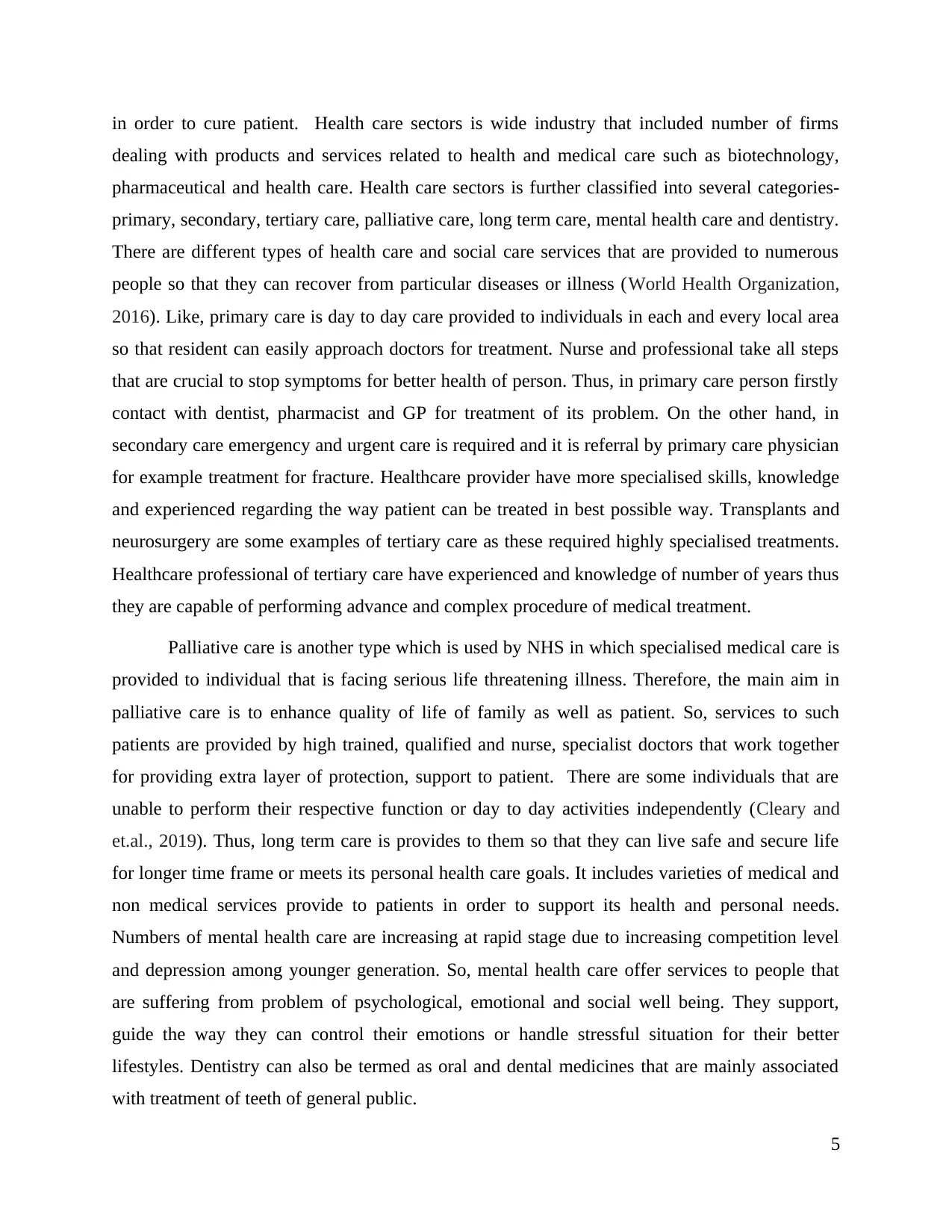
in order to cure patient. Health care sectors is wide industry that included number of firms
dealing with products and services related to health and medical care such as biotechnology,
pharmaceutical and health care. Health care sectors is further classified into several categories-
primary, secondary, tertiary care, palliative care, long term care, mental health care and dentistry.
There are different types of health care and social care services that are provided to numerous
people so that they can recover from particular diseases or illness (World Health Organization,
2016). Like, primary care is day to day care provided to individuals in each and every local area
so that resident can easily approach doctors for treatment. Nurse and professional take all steps
that are crucial to stop symptoms for better health of person. Thus, in primary care person firstly
contact with dentist, pharmacist and GP for treatment of its problem. On the other hand, in
secondary care emergency and urgent care is required and it is referral by primary care physician
for example treatment for fracture. Healthcare provider have more specialised skills, knowledge
and experienced regarding the way patient can be treated in best possible way. Transplants and
neurosurgery are some examples of tertiary care as these required highly specialised treatments.
Healthcare professional of tertiary care have experienced and knowledge of number of years thus
they are capable of performing advance and complex procedure of medical treatment.
Palliative care is another type which is used by NHS in which specialised medical care is
provided to individual that is facing serious life threatening illness. Therefore, the main aim in
palliative care is to enhance quality of life of family as well as patient. So, services to such
patients are provided by high trained, qualified and nurse, specialist doctors that work together
for providing extra layer of protection, support to patient. There are some individuals that are
unable to perform their respective function or day to day activities independently (Cleary and
et.al., 2019). Thus, long term care is provides to them so that they can live safe and secure life
for longer time frame or meets its personal health care goals. It includes varieties of medical and
non medical services provide to patients in order to support its health and personal needs.
Numbers of mental health care are increasing at rapid stage due to increasing competition level
and depression among younger generation. So, mental health care offer services to people that
are suffering from problem of psychological, emotional and social well being. They support,
guide the way they can control their emotions or handle stressful situation for their better
lifestyles. Dentistry can also be termed as oral and dental medicines that are mainly associated
with treatment of teeth of general public.
5
dealing with products and services related to health and medical care such as biotechnology,
pharmaceutical and health care. Health care sectors is further classified into several categories-
primary, secondary, tertiary care, palliative care, long term care, mental health care and dentistry.
There are different types of health care and social care services that are provided to numerous
people so that they can recover from particular diseases or illness (World Health Organization,
2016). Like, primary care is day to day care provided to individuals in each and every local area
so that resident can easily approach doctors for treatment. Nurse and professional take all steps
that are crucial to stop symptoms for better health of person. Thus, in primary care person firstly
contact with dentist, pharmacist and GP for treatment of its problem. On the other hand, in
secondary care emergency and urgent care is required and it is referral by primary care physician
for example treatment for fracture. Healthcare provider have more specialised skills, knowledge
and experienced regarding the way patient can be treated in best possible way. Transplants and
neurosurgery are some examples of tertiary care as these required highly specialised treatments.
Healthcare professional of tertiary care have experienced and knowledge of number of years thus
they are capable of performing advance and complex procedure of medical treatment.
Palliative care is another type which is used by NHS in which specialised medical care is
provided to individual that is facing serious life threatening illness. Therefore, the main aim in
palliative care is to enhance quality of life of family as well as patient. So, services to such
patients are provided by high trained, qualified and nurse, specialist doctors that work together
for providing extra layer of protection, support to patient. There are some individuals that are
unable to perform their respective function or day to day activities independently (Cleary and
et.al., 2019). Thus, long term care is provides to them so that they can live safe and secure life
for longer time frame or meets its personal health care goals. It includes varieties of medical and
non medical services provide to patients in order to support its health and personal needs.
Numbers of mental health care are increasing at rapid stage due to increasing competition level
and depression among younger generation. So, mental health care offer services to people that
are suffering from problem of psychological, emotional and social well being. They support,
guide the way they can control their emotions or handle stressful situation for their better
lifestyles. Dentistry can also be termed as oral and dental medicines that are mainly associated
with treatment of teeth of general public.
5
Paraphrase This Document
Need a fresh take? Get an instant paraphrase of this document with our AI Paraphraser
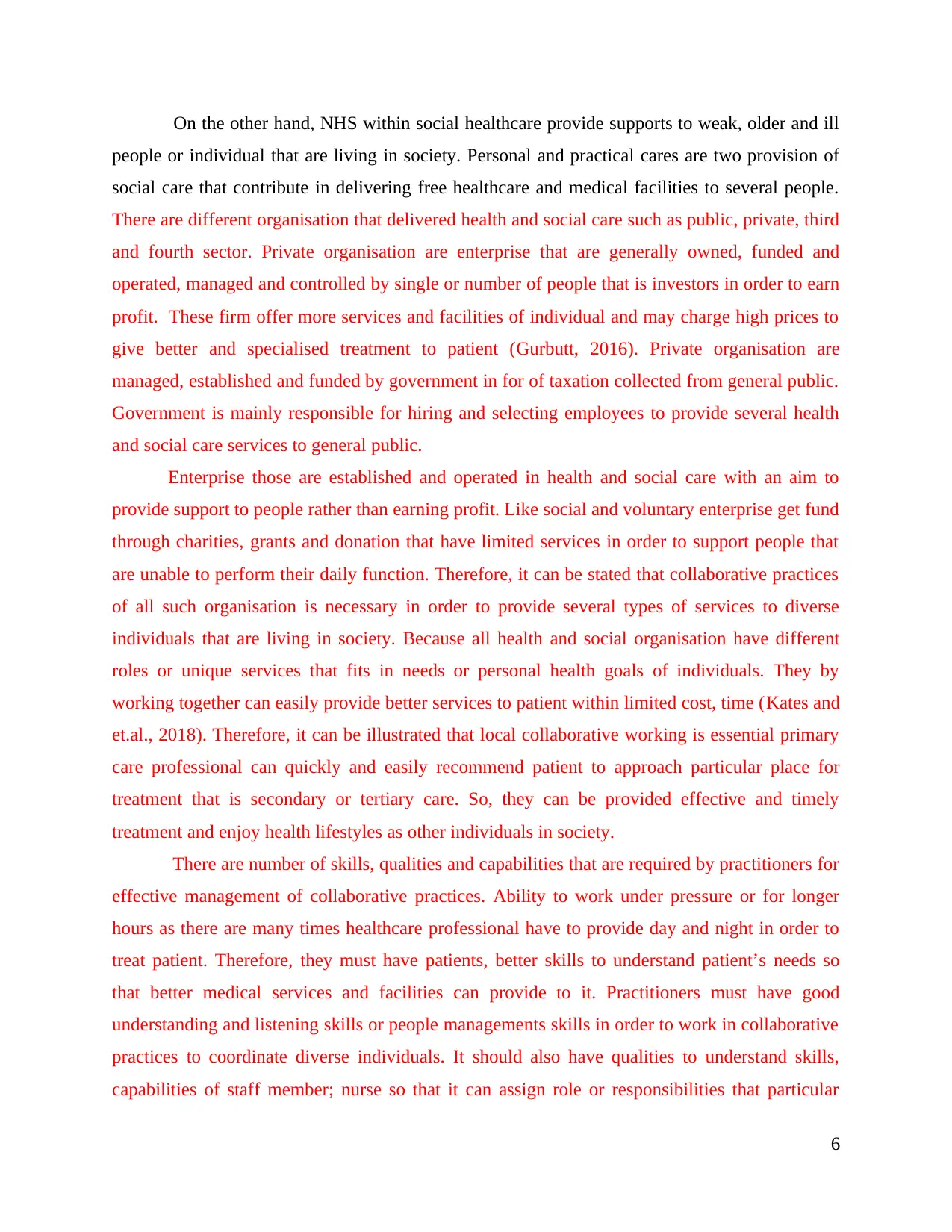
On the other hand, NHS within social healthcare provide supports to weak, older and ill
people or individual that are living in society. Personal and practical cares are two provision of
social care that contribute in delivering free healthcare and medical facilities to several people.
There are different organisation that delivered health and social care such as public, private, third
and fourth sector. Private organisation are enterprise that are generally owned, funded and
operated, managed and controlled by single or number of people that is investors in order to earn
profit. These firm offer more services and facilities of individual and may charge high prices to
give better and specialised treatment to patient (Gurbutt, 2016). Private organisation are
managed, established and funded by government in for of taxation collected from general public.
Government is mainly responsible for hiring and selecting employees to provide several health
and social care services to general public.
Enterprise those are established and operated in health and social care with an aim to
provide support to people rather than earning profit. Like social and voluntary enterprise get fund
through charities, grants and donation that have limited services in order to support people that
are unable to perform their daily function. Therefore, it can be stated that collaborative practices
of all such organisation is necessary in order to provide several types of services to diverse
individuals that are living in society. Because all health and social organisation have different
roles or unique services that fits in needs or personal health goals of individuals. They by
working together can easily provide better services to patient within limited cost, time (Kates and
et.al., 2018). Therefore, it can be illustrated that local collaborative working is essential primary
care professional can quickly and easily recommend patient to approach particular place for
treatment that is secondary or tertiary care. So, they can be provided effective and timely
treatment and enjoy health lifestyles as other individuals in society.
There are number of skills, qualities and capabilities that are required by practitioners for
effective management of collaborative practices. Ability to work under pressure or for longer
hours as there are many times healthcare professional have to provide day and night in order to
treat patient. Therefore, they must have patients, better skills to understand patient’s needs so
that better medical services and facilities can provide to it. Practitioners must have good
understanding and listening skills or people managements skills in order to work in collaborative
practices to coordinate diverse individuals. It should also have qualities to understand skills,
capabilities of staff member; nurse so that it can assign role or responsibilities that particular
6
people or individual that are living in society. Personal and practical cares are two provision of
social care that contribute in delivering free healthcare and medical facilities to several people.
There are different organisation that delivered health and social care such as public, private, third
and fourth sector. Private organisation are enterprise that are generally owned, funded and
operated, managed and controlled by single or number of people that is investors in order to earn
profit. These firm offer more services and facilities of individual and may charge high prices to
give better and specialised treatment to patient (Gurbutt, 2016). Private organisation are
managed, established and funded by government in for of taxation collected from general public.
Government is mainly responsible for hiring and selecting employees to provide several health
and social care services to general public.
Enterprise those are established and operated in health and social care with an aim to
provide support to people rather than earning profit. Like social and voluntary enterprise get fund
through charities, grants and donation that have limited services in order to support people that
are unable to perform their daily function. Therefore, it can be stated that collaborative practices
of all such organisation is necessary in order to provide several types of services to diverse
individuals that are living in society. Because all health and social organisation have different
roles or unique services that fits in needs or personal health goals of individuals. They by
working together can easily provide better services to patient within limited cost, time (Kates and
et.al., 2018). Therefore, it can be illustrated that local collaborative working is essential primary
care professional can quickly and easily recommend patient to approach particular place for
treatment that is secondary or tertiary care. So, they can be provided effective and timely
treatment and enjoy health lifestyles as other individuals in society.
There are number of skills, qualities and capabilities that are required by practitioners for
effective management of collaborative practices. Ability to work under pressure or for longer
hours as there are many times healthcare professional have to provide day and night in order to
treat patient. Therefore, they must have patients, better skills to understand patient’s needs so
that better medical services and facilities can provide to it. Practitioners must have good
understanding and listening skills or people managements skills in order to work in collaborative
practices to coordinate diverse individuals. It should also have qualities to understand skills,
capabilities of staff member; nurse so that it can assign role or responsibilities that particular
6
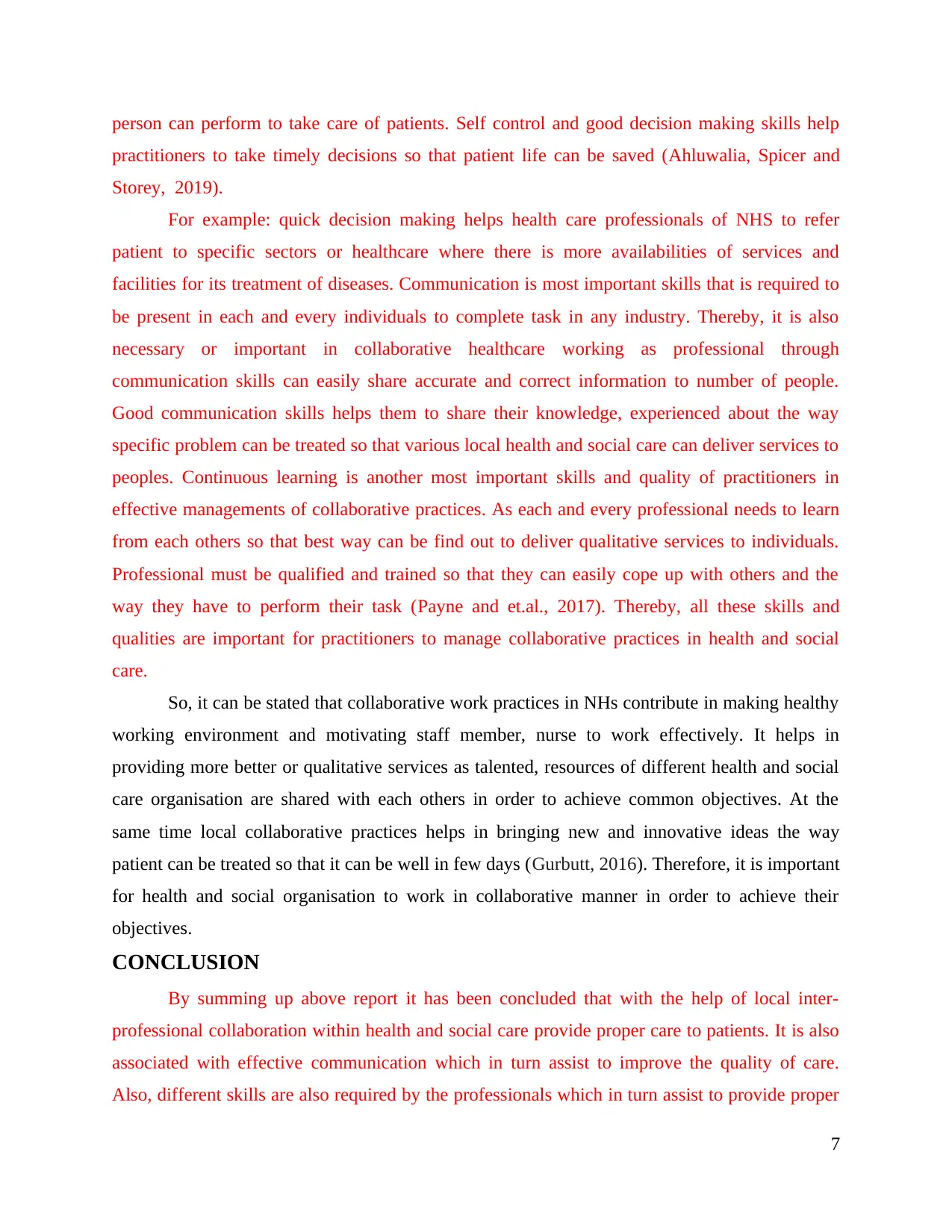
person can perform to take care of patients. Self control and good decision making skills help
practitioners to take timely decisions so that patient life can be saved (Ahluwalia, Spicer and
Storey, 2019).
For example: quick decision making helps health care professionals of NHS to refer
patient to specific sectors or healthcare where there is more availabilities of services and
facilities for its treatment of diseases. Communication is most important skills that is required to
be present in each and every individuals to complete task in any industry. Thereby, it is also
necessary or important in collaborative healthcare working as professional through
communication skills can easily share accurate and correct information to number of people.
Good communication skills helps them to share their knowledge, experienced about the way
specific problem can be treated so that various local health and social care can deliver services to
peoples. Continuous learning is another most important skills and quality of practitioners in
effective managements of collaborative practices. As each and every professional needs to learn
from each others so that best way can be find out to deliver qualitative services to individuals.
Professional must be qualified and trained so that they can easily cope up with others and the
way they have to perform their task (Payne and et.al., 2017). Thereby, all these skills and
qualities are important for practitioners to manage collaborative practices in health and social
care.
So, it can be stated that collaborative work practices in NHs contribute in making healthy
working environment and motivating staff member, nurse to work effectively. It helps in
providing more better or qualitative services as talented, resources of different health and social
care organisation are shared with each others in order to achieve common objectives. At the
same time local collaborative practices helps in bringing new and innovative ideas the way
patient can be treated so that it can be well in few days (Gurbutt, 2016). Therefore, it is important
for health and social organisation to work in collaborative manner in order to achieve their
objectives.
CONCLUSION
By summing up above report it has been concluded that with the help of local inter-
professional collaboration within health and social care provide proper care to patients. It is also
associated with effective communication which in turn assist to improve the quality of care.
Also, different skills are also required by the professionals which in turn assist to provide proper
7
practitioners to take timely decisions so that patient life can be saved (Ahluwalia, Spicer and
Storey, 2019).
For example: quick decision making helps health care professionals of NHS to refer
patient to specific sectors or healthcare where there is more availabilities of services and
facilities for its treatment of diseases. Communication is most important skills that is required to
be present in each and every individuals to complete task in any industry. Thereby, it is also
necessary or important in collaborative healthcare working as professional through
communication skills can easily share accurate and correct information to number of people.
Good communication skills helps them to share their knowledge, experienced about the way
specific problem can be treated so that various local health and social care can deliver services to
peoples. Continuous learning is another most important skills and quality of practitioners in
effective managements of collaborative practices. As each and every professional needs to learn
from each others so that best way can be find out to deliver qualitative services to individuals.
Professional must be qualified and trained so that they can easily cope up with others and the
way they have to perform their task (Payne and et.al., 2017). Thereby, all these skills and
qualities are important for practitioners to manage collaborative practices in health and social
care.
So, it can be stated that collaborative work practices in NHs contribute in making healthy
working environment and motivating staff member, nurse to work effectively. It helps in
providing more better or qualitative services as talented, resources of different health and social
care organisation are shared with each others in order to achieve common objectives. At the
same time local collaborative practices helps in bringing new and innovative ideas the way
patient can be treated so that it can be well in few days (Gurbutt, 2016). Therefore, it is important
for health and social organisation to work in collaborative manner in order to achieve their
objectives.
CONCLUSION
By summing up above report it has been concluded that with the help of local inter-
professional collaboration within health and social care provide proper care to patients. It is also
associated with effective communication which in turn assist to improve the quality of care.
Also, different skills are also required by the professionals which in turn assist to provide proper
7
⊘ This is a preview!⊘
Do you want full access?
Subscribe today to unlock all pages.

Trusted by 1+ million students worldwide
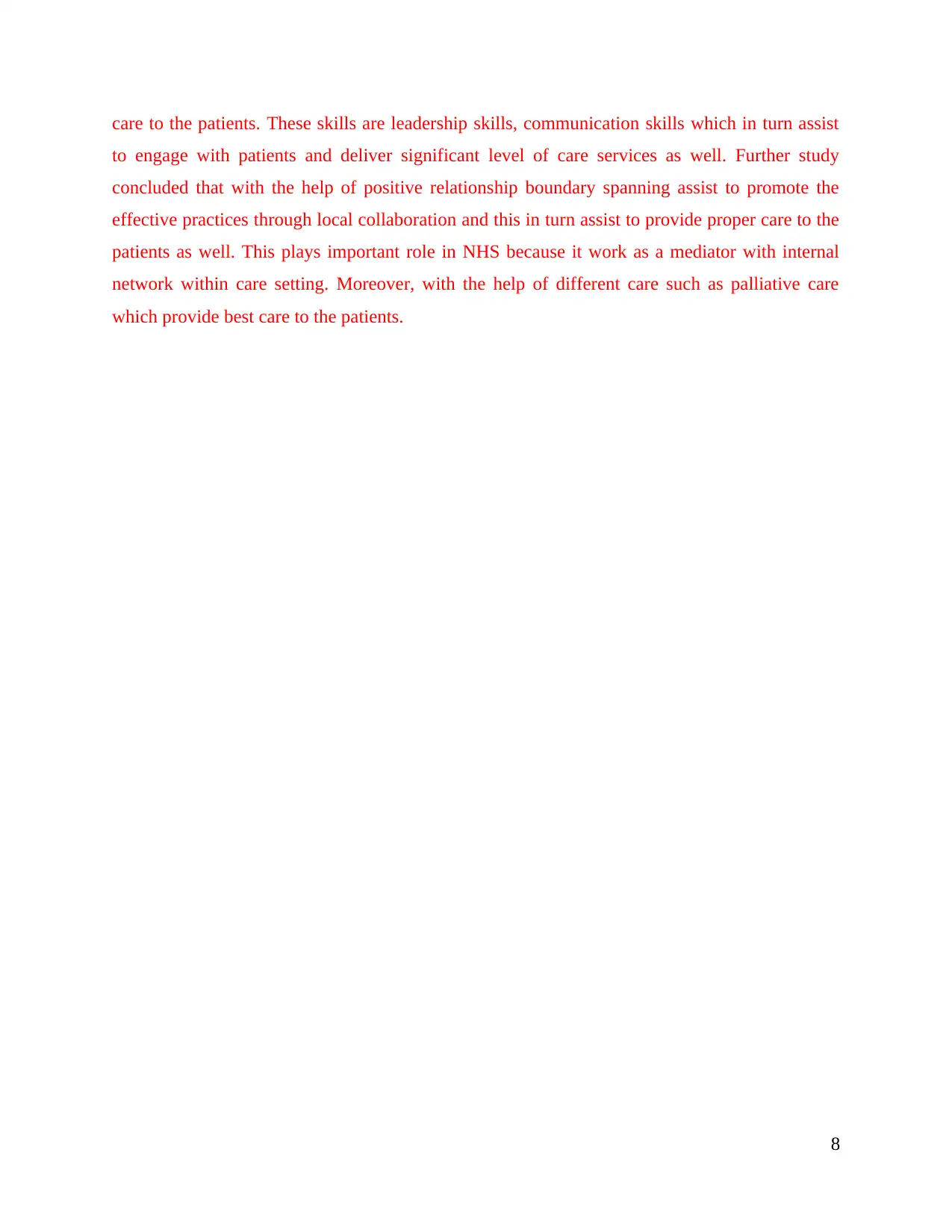
care to the patients. These skills are leadership skills, communication skills which in turn assist
to engage with patients and deliver significant level of care services as well. Further study
concluded that with the help of positive relationship boundary spanning assist to promote the
effective practices through local collaboration and this in turn assist to provide proper care to the
patients as well. This plays important role in NHS because it work as a mediator with internal
network within care setting. Moreover, with the help of different care such as palliative care
which provide best care to the patients.
8
to engage with patients and deliver significant level of care services as well. Further study
concluded that with the help of positive relationship boundary spanning assist to promote the
effective practices through local collaboration and this in turn assist to provide proper care to the
patients as well. This plays important role in NHS because it work as a mediator with internal
network within care setting. Moreover, with the help of different care such as palliative care
which provide best care to the patients.
8
Paraphrase This Document
Need a fresh take? Get an instant paraphrase of this document with our AI Paraphraser
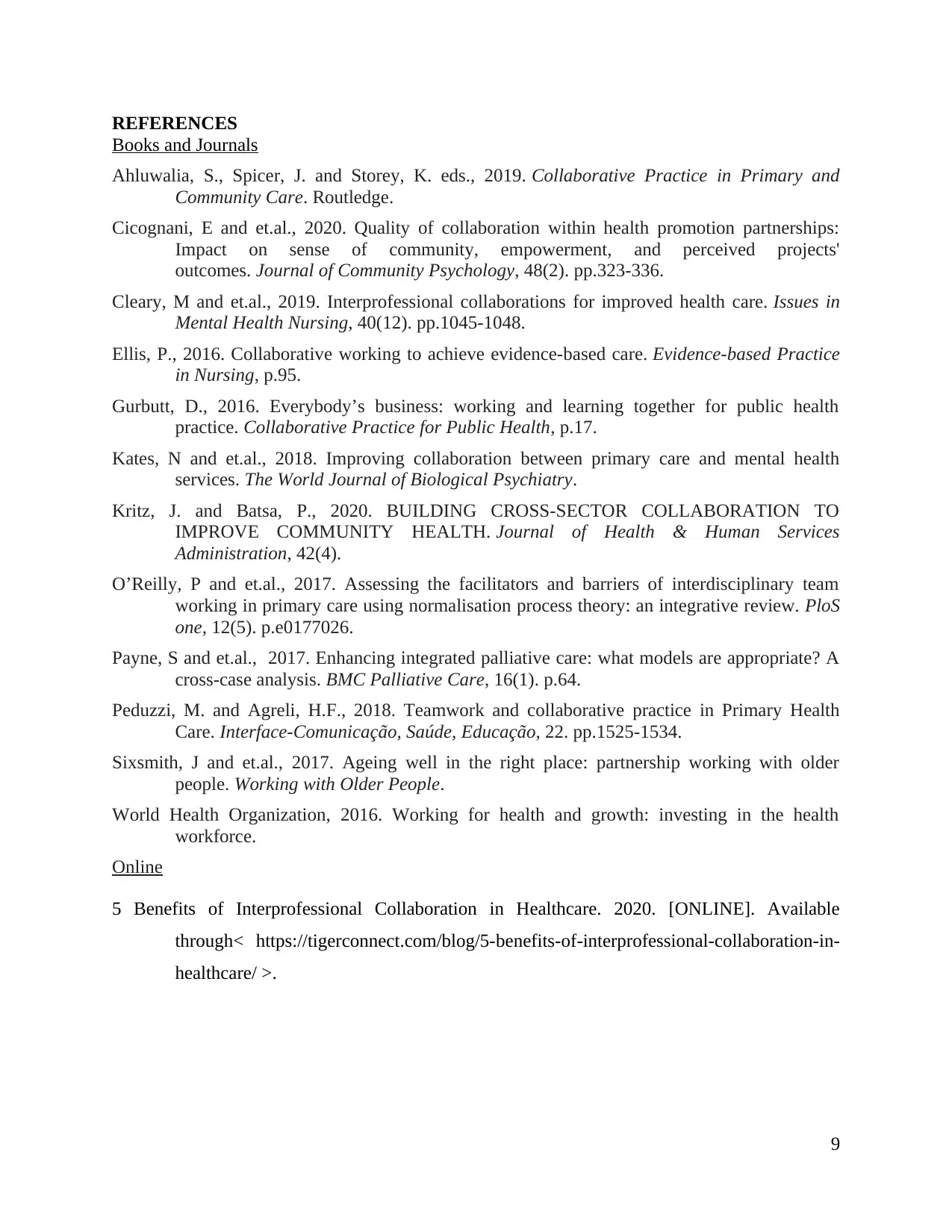
REFERENCES
Books and Journals
Ahluwalia, S., Spicer, J. and Storey, K. eds., 2019. Collaborative Practice in Primary and
Community Care. Routledge.
Cicognani, E and et.al., 2020. Quality of collaboration within health promotion partnerships:
Impact on sense of community, empowerment, and perceived projects'
outcomes. Journal of Community Psychology, 48(2). pp.323-336.
Cleary, M and et.al., 2019. Interprofessional collaborations for improved health care. Issues in
Mental Health Nursing, 40(12). pp.1045-1048.
Ellis, P., 2016. Collaborative working to achieve evidence-based care. Evidence-based Practice
in Nursing, p.95.
Gurbutt, D., 2016. Everybody’s business: working and learning together for public health
practice. Collaborative Practice for Public Health, p.17.
Kates, N and et.al., 2018. Improving collaboration between primary care and mental health
services. The World Journal of Biological Psychiatry.
Kritz, J. and Batsa, P., 2020. BUILDING CROSS-SECTOR COLLABORATION TO
IMPROVE COMMUNITY HEALTH. Journal of Health & Human Services
Administration, 42(4).
O’Reilly, P and et.al., 2017. Assessing the facilitators and barriers of interdisciplinary team
working in primary care using normalisation process theory: an integrative review. PloS
one, 12(5). p.e0177026.
Payne, S and et.al., 2017. Enhancing integrated palliative care: what models are appropriate? A
cross-case analysis. BMC Palliative Care, 16(1). p.64.
Peduzzi, M. and Agreli, H.F., 2018. Teamwork and collaborative practice in Primary Health
Care. Interface-Comunicação, Saúde, Educação, 22. pp.1525-1534.
Sixsmith, J and et.al., 2017. Ageing well in the right place: partnership working with older
people. Working with Older People.
World Health Organization, 2016. Working for health and growth: investing in the health
workforce.
Online
5 Benefits of Interprofessional Collaboration in Healthcare. 2020. [ONLINE]. Available
through< https://tigerconnect.com/blog/5-benefits-of-interprofessional-collaboration-in-
healthcare/ >.
9
Books and Journals
Ahluwalia, S., Spicer, J. and Storey, K. eds., 2019. Collaborative Practice in Primary and
Community Care. Routledge.
Cicognani, E and et.al., 2020. Quality of collaboration within health promotion partnerships:
Impact on sense of community, empowerment, and perceived projects'
outcomes. Journal of Community Psychology, 48(2). pp.323-336.
Cleary, M and et.al., 2019. Interprofessional collaborations for improved health care. Issues in
Mental Health Nursing, 40(12). pp.1045-1048.
Ellis, P., 2016. Collaborative working to achieve evidence-based care. Evidence-based Practice
in Nursing, p.95.
Gurbutt, D., 2016. Everybody’s business: working and learning together for public health
practice. Collaborative Practice for Public Health, p.17.
Kates, N and et.al., 2018. Improving collaboration between primary care and mental health
services. The World Journal of Biological Psychiatry.
Kritz, J. and Batsa, P., 2020. BUILDING CROSS-SECTOR COLLABORATION TO
IMPROVE COMMUNITY HEALTH. Journal of Health & Human Services
Administration, 42(4).
O’Reilly, P and et.al., 2017. Assessing the facilitators and barriers of interdisciplinary team
working in primary care using normalisation process theory: an integrative review. PloS
one, 12(5). p.e0177026.
Payne, S and et.al., 2017. Enhancing integrated palliative care: what models are appropriate? A
cross-case analysis. BMC Palliative Care, 16(1). p.64.
Peduzzi, M. and Agreli, H.F., 2018. Teamwork and collaborative practice in Primary Health
Care. Interface-Comunicação, Saúde, Educação, 22. pp.1525-1534.
Sixsmith, J and et.al., 2017. Ageing well in the right place: partnership working with older
people. Working with Older People.
World Health Organization, 2016. Working for health and growth: investing in the health
workforce.
Online
5 Benefits of Interprofessional Collaboration in Healthcare. 2020. [ONLINE]. Available
through< https://tigerconnect.com/blog/5-benefits-of-interprofessional-collaboration-in-
healthcare/ >.
9
1 out of 11
Related Documents
Your All-in-One AI-Powered Toolkit for Academic Success.
+13062052269
info@desklib.com
Available 24*7 on WhatsApp / Email
![[object Object]](/_next/static/media/star-bottom.7253800d.svg)
Unlock your academic potential
Copyright © 2020–2025 A2Z Services. All Rights Reserved. Developed and managed by ZUCOL.




